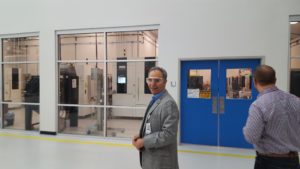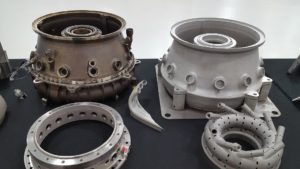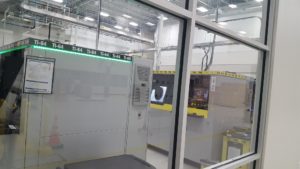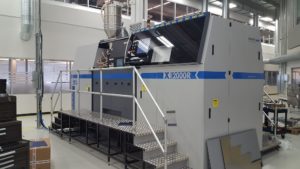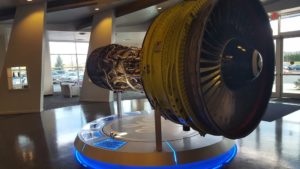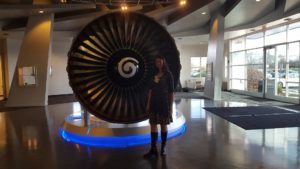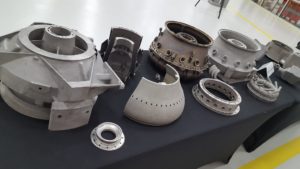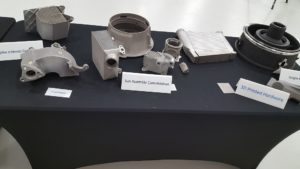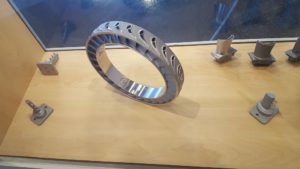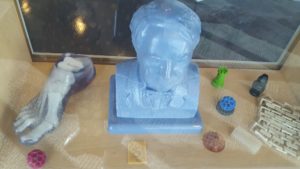 The GE Additive Technology Center (ATC) in Cincinnati, Ohio is housed in a former Dell building that has become the center for GE Additive‘s latest efforts in additive manufacturing since its 2015 opening. More than 350 employees and over 100 metal additive manufacturing systems now work in the facility, which I was invited to visit last week for an exclusive first look at the company’s new binder jetting technology.
The GE Additive Technology Center (ATC) in Cincinnati, Ohio is housed in a former Dell building that has become the center for GE Additive‘s latest efforts in additive manufacturing since its 2015 opening. More than 350 employees and over 100 metal additive manufacturing systems now work in the facility, which I was invited to visit last week for an exclusive first look at the company’s new binder jetting technology.
GE Additive has been focused on not only embracing 3D printing technologies, but advancing them. GE as a whole encompasses myraid businesses around the world, many of which are putting the latest technologies to use internally in addition to selling equipment. Additive manufacturing is felt keenly through in the operations of GE Aviation, which made waves with the first metal 3D printed fuel nozzle for its LEAP engines, following the 2012 acquisition of Cincinnati-based Morris Technologies. GE sees the potential for further incorporation of additive manufacturing into jet engine production, as this application can benefit from the unique geometries, reduced assemblies, and lightweighting made possible through 3D printing. The company has been underscoring the importance of additive manufacturing to its business strategies and operations, and is certainly putting its money where its mouth is through last year’s billion-dollar acquisitions of Arcam and Concept Laser, as well as this year’s introduction, Project A.T.L.A.S. — and now the prototype of the new binder jetting system.
Inside the ATC, I appreciated the opportunity for a personal tour from GE Additive Vice President and General Manager Mohammad Ehteshami and many of the senior team members who developed the binder jetting machine. Safety glasses in place, we walked through the large space that houses metal 3D printers from Concept Laser and Arcam, many labeled with the specific metals each machine is dedicated to working with.
Concept Laser’s large — 800 x 400 x 500 mm — X LINE 2000R machine, with the recently rebranded blue logo, was prominent in the space. Behind closed doors I also saw five of the earliest meter-class Project A.T.L.A.S. machines; at formnext, I had seen serial number 1, Ehteshami noted, while #2 is housed in Concept Laser’s Lichtenfels facility. Serial numbers 3 through 7 are at the ATC, where they are each for the most part working with different materials, though these systems had “not been prettied up yet” and so were a bit camera-shy.
“We’ve sold all the machines we’re building already,” Ehteshami added as we looked at these systems. “Some are to GE internally, but a lot of sales are external.”
- Mohammad Ehteshami in front of a room housing Arcam and Concept Laser equipment
- Left: a traditionally manufactured component made in 305 parts; right, the same component redesigned and produced via additive manufacturing in 1 part
Throughout the facility, additive manufacturing systems are working with a vast array of metals; among those Ehteshami named as we walked were stainless steel, cobalt base, nickel base, aluminum, Inconcel, and titanium, in what he described as “the whole spectrum to enable GE and industry.” 3D printing is present as well in other technologies that GE works with, including polymers. A desktop 3D printer from Dremel allows the GE team to test out designs on a smaller scale, for instance.

Designs for the binder jetting system, which was created in just 47 days as commemorated by “47” as the first print from the machine; seen with a green aerospace component
This year, GE dedicated $200 million to R&D efforts, and has been expanding customer outreach as well, focusing on lowering barriers to entry for additive manufacturing. Among the major efforts from 2017 that Ehteshami underscored are GE’s new Customer Experience Center in Munich, which opened just two days before my visit; Concept Laser’s new 3D Campus in Lichtenfels; and the GE Additive Education Program having donated 400 additive manufacturing systems to schools. Last year, GE Additive also opened a key facility in Pittsburgh with the $40 million Center for Additive Technology Advancement (CATA). Each of these efforts is targeted at exposing more potential users to the hows and whys of additive manufacturing, with full training and support.
“We donated 400 machines to schools, so they can understand what additive is; we will continue this initiative for the next three or four years,” Ehteshami told me of the educational program.
Looking toward customer centers, he continued, “We have centers in Pittsburgh and Munich, and we are working with governments to have centers in every corner of the world that makes sense. We are even looking at micro-factories. We want to accelerate technology, create jobs, and educate. We want to make sure that additive is something that is taken notice of.”
 When I asked him about barriers to entry into industrial 3D printing, he pointed to a few challenges that need to be overcome, along with silver linings of accessibility.
When I asked him about barriers to entry into industrial 3D printing, he pointed to a few challenges that need to be overcome, along with silver linings of accessibility.
“Barriers are less in terms of capital, as we look at binder jetting. For a casting house to be established, it needs thousands of millions of dollars; additive can be set up with a few million dollars,” he noted.
While “a few million dollars” may still inhibit investment into industrial binder jetting systems for some operations, the hope is that their disruptive potential will offer what is ultimately a more cost-effective solution for such applications. Still, there are definite barriers holding back wider adoption of additive manufacturing overall in the near term.
“Challenges exist in making parts, in creating certified parts,” Ehteshami said, pointing to federal aviation regulations to meet in aerospace verticals and FDA certifications for medical applications.
“Education remains a barrier. We are donating machines to young kids, especially for schools that can’t afford this equipment on their own; we are helping to create curriculum offerings for universities. We are offering financing for customers who need it. We are creating better, faster machines so cost of ownership is lower.”
He pointed to GE as a “proof of concept” for integrating additive manufacturing throughout business operations. With the company as a symbolic city on a hill, it can serve as an example of how the technology can be used for impactful, real-world applications. Because GE has operations encompassing materials, machines, and software, the company is unusually well equipped to provide supplies, services, and support — along with what Ehteshami described as a “holistic view” that provides an advantage where, because GE consumes these products, they also understand where improvements need to happen.
In discussing adoption and how GE hopes to encourage efforts, I asked next about training efforts in design, as design for additive manufacture (DfAM) has very different constraints and requirements than those many industrial designers are familiar with through traditional, subtractive manufacturing techniques.
“Our customer experience centers provide a big help — here at the ATC, at CATA in Pittsburgh, in Munich — we bring the customer in, and collaborate to teach design for additive. They can use the centers for prototyping or do low rates of production. When the machine is sent home, we send a team with it to set up. This accelerates adoption,” he said.
In Munich, about 150 customers have joined already to explore GE’s offerings, he noted. These services and support are available now in Cincinnati, Pittsburgh, and Munich, and GE is looking to continue to broaden the impact through its efforts with universities and outreach. Among those visiting the established centers have been local businesses, as well as those who have visited from areas including Japan, the Middle East, and Africa to learn more about additive manufacturing.
“When they come in, they don’t believe what’s happened,” Ehteshami said of many global visitors’ reactions. “They leave asking how to reproduce what they’ve seen.”
- Me for scale
As the 3D printing industry continues to globalize, I asked Ehteshami for his views on certain aspects of growth. Much of the growth currently taking place in additive manufacturing was best illustrated at this year’s formnext in Frankfurt, where many industry participants noted an increase in professional focus as more than 21,000 visitors attended the largest-ever event dedicated to 3D printing.
“This year’s formnext was incredible, with growth, with energy… The size of formnext this year showed that there are a lot of companies pushing for more durable materials, faster machcines, lower cost of operation, lower cost per pound of material… From last year to this year, additive grew $2.5 billion worldwide; the industry is growing at a 25-30% CAGR,” Ehteshami said.
He turned to GE’s participation and views on growth, noting, “We closed on Concept Laser and Arcam almost exactly one year ago — and our entrance was noticed. A lot of people took that as a turning point. If you convert 0.5% of overall manufacturing — and of that, who takes how much? Who knows — this industry will have a major impact. We now play in three modalities and we plan to play in more, as it makes sense.”
Aerospace, again, will play a major role in future technology decisions GE makes. With applications in jet engines and rising demand across aviation, along with partners seeking certification, this vertical is effectively “always the first one” to see new developments.
“We are very bullish on the growth of additive,” Ehteshami said mildly.
Looking more deeply into GE-specific factors, discussion turned to company operation and strategies.
As attention around the world, and in 3D printing, increasingly focuses on diversity and fair treatment of and equal opportunities for all participants, I asked Ehteshami about GE’s views on diversity. The company has been working to raise the profile of a wider cross-section of employees, and Ehteshami said that across the approximately 1200 team members working with GE Additive operations in Ohio, Pittsburgh, New York, Auburn, Texas, the US West Coast, Italy, Germany, Sweden, and more, “diversity is incredibly good,” with a high percentage of women represented on teams.
“AddWorks, for example, is about 30% female and growing in that. We are blessed. This industry requires creative minds, and we get that from every corner of the globe; our diversity is fantastic,” he told me. “With teams in different countries, we are quite diverse — but we always need to do more when it comes to diversity, when it comes to creativity especially.”
 Another aspect of business operations that we talked about focused more on the acquired companies’ integration under the GE Additive umbrella. While I recently talked with Concept Laser’s CEO about his views on the relationship, last week Arcam announced the pending departures of its CEO and CFO.
Another aspect of business operations that we talked about focused more on the acquired companies’ integration under the GE Additive umbrella. While I recently talked with Concept Laser’s CEO about his views on the relationship, last week Arcam announced the pending departures of its CEO and CFO.
“I have tremendous respect for Magnus [René, CEO] and Johan [Brandt, CFO and Deputy CEO],” Ehteshami began.
“They came to the board and requested to do something else. To the best of my knowledge, there was no disagreement at all. This was a decision by Arcam, not GE. Our relationship is very positive and we wish them well. The board of Arcam will name their replacements in due time.”
I asked if the resignations were a surprise: “Not really.”
“We always see some movement when acquiring companies. I won’t expect [new appointments] to be too long in coming. Integration is always good, we are all always learning. Arcam is a public company, and the board will decide and announce the next steps,” he said.
For his part, Ehteshami began his work with GE Additive at a time when he had been thinking of moving into retirement. Working with additive manufacturing every day is invigorating for him, and is certainly keeping him on the go.
“Now, at age 62, I spend maybe 60% of my time going to places and giving talks; it’s amazing to see young people get excited,” he said, noting as well that every day he begins with a run and has only missed a single morning run in 2017.
Many of these runs have been on different continents, as his position allows him a truly global perspective on the growth of the industry, with the travels and talks keeping him directly in touch with participants and potential adopters. Among the countries Ehteshami sees as being especially fast-moving in adopting additive manufacturing into business strategies are the US, Germany, China, Nordic countries, and a few more; “Japan is coming along, and Italy and the UK are doing really well.” Key in many of these areas is support from their governments for the development of advanced technologies including industrial 3D printing.

With the team: Mohammad Ehteshami, Vice President & General Manager, GE Additive; Travis Sands, Breakout Technology Leader, GE Additive; Sarah Goehrke, Editor-in-Chief, 3DPrint.com; Victor Fulton, Lead Designer, GE Additive; Carlos Bonilla, Lead Mechanical Engineer, GE Additive; Vadim Bromberg, Lead Mechanical Engineer, GE Global Research Center (GRC), Niskayuna, NY; Brian Sechrist, Senior Manufacturing Engineer, GE Additive
An important factor to GE’s momentum in the space comes down to one aspect Ehteshami was quick to point out: its teams.
“We are a very humble organization, and truly, truly believe our best product is our people,” he said.
“We are picking up steam and running faster. I like to say that this industry still makes me feel like an 18-year-old boy.”
As GE Additive continues to develop and push forward with new technologies, including now three technologies for metal additive manufacturing, these modalities and the mentality behind them showcase a true top-to-bottom organizational dedication to the future of 3D printing.
The company will continue to expand its offerings, and to hone existing portfolio technologies, benefiting from true integration of its own internal expertise and offerings. Looking to disrupt industry with advanced manufacturing technologies, GE shows drive toward the future of industry — and, uniquely, many of the most important resources to drive such disruption.
Discuss binder jetting and other 3D printing topics at 3DPrintBoard.com or share your thoughts in the comments below.
[Photos: Sarah Goehrke]
Subscribe to Our Email Newsletter
Stay up-to-date on all the latest news from the 3D printing industry and receive information and offers from third party vendors.
You May Also Like
3D Printing News Briefs, April 13, 2024: Robotics, Orthotics, & Hypersonics
In 3D Printing News Briefs today, we’re focusing first on robotics, as Carnegie Mellon University’s new Robotics Innovation Center will house several community outreach programs, and Ugogo3D is now working...
Rail Giant Alstom Saves $15M with 3D Printing Automation Software 3D Spark
3D Spark has entered into a three-year deal with the rail giant Alstom. Alstom, a transport behemoth with annual revenues of $16 billion, specializes in the manufacture of trains, trams,...
Meltio Expands Global Reach with New Partnerships in the Americas and Europe
Spanish 3D printing manufacturer Meltio has expanded its sales network across the globe. With the addition of three new partners in the United States, Brazil, Argentina, and Italy, Meltio aims...
3D Printing Webinar and Event Roundup: April 7, 2024
Webinars and events in the 3D printing industry are picking back up this week! Sea-Air-Space is coming to Maryland, and SAE International is sponsoring a 3D Systems webinar about 3D...



